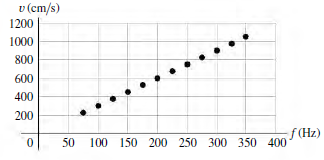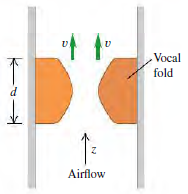The wave speed is measured for different vibration frequencies. A graph of the wave speed as a
Question:
(a) Increases;
(b) Decreases;
(c) Doesn€™t change;
(d) Becomes undefined.
Figure P15.80

In the larynx, sound is produced by the vibration of the vocal folds (also called €œvocal cords€). The accompanying figure is a cross section of the vocal tract at one instant in time. Air flows upward (in the +z direction) through the vocal tract, causing a transverse wave to propagate vertically upward along the surface of the vocal folds. In a typical adult male, the thickness of the vocal folds in the direction of airflow is d = 2.0 mm. High speed photography shows that for a frequency of vibration of f = 125 Hz, the wave along the surface of the vocal folds travels upward at a speed of v = 375 cm/s. Use t for time, z for displacement in the +z-direction, and l for wavelength.

Step by Step Answer:

University Physics with Modern Physics
ISBN: 978-0133977981
14th edition
Authors: Hugh D. Young, Roger A. Freedman





